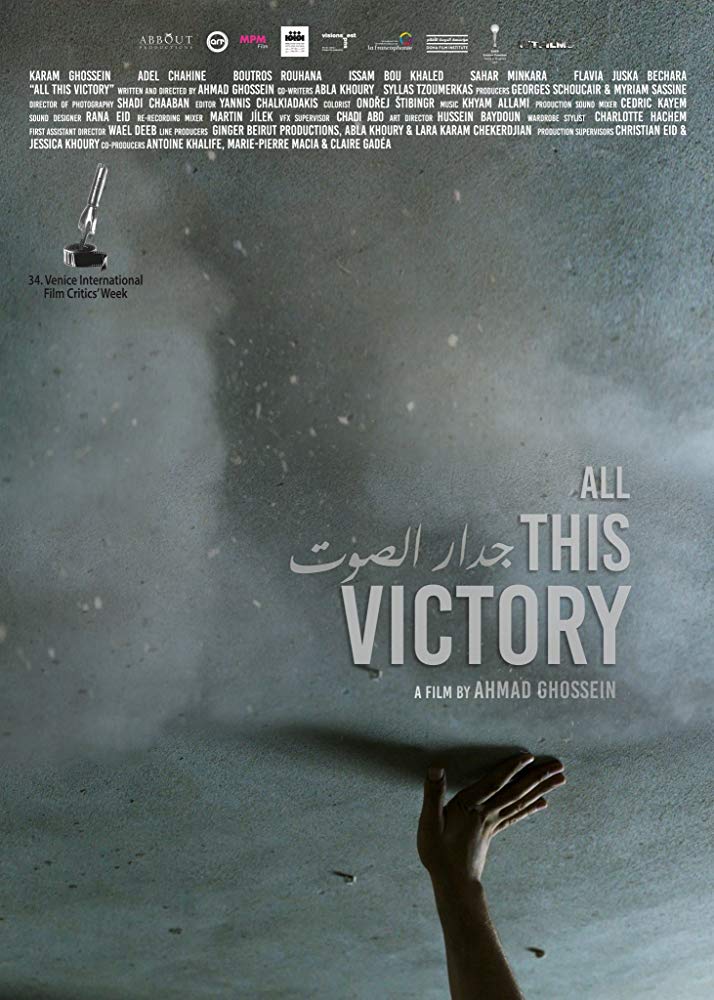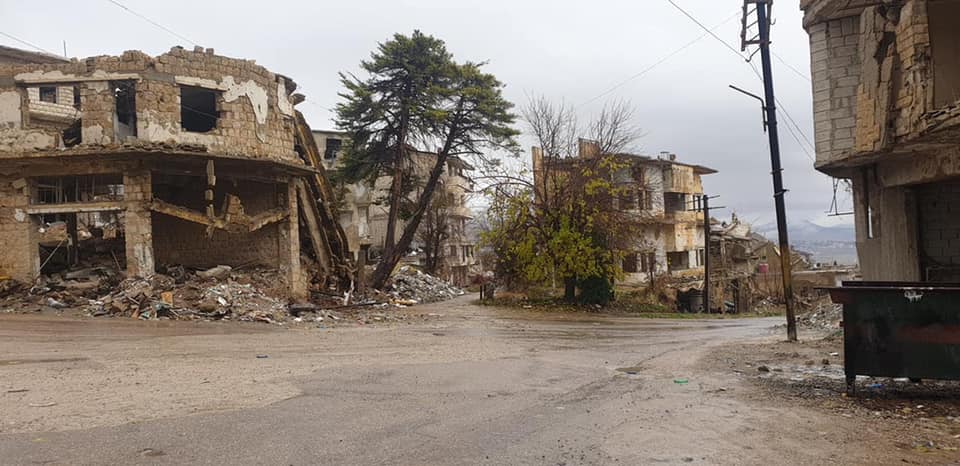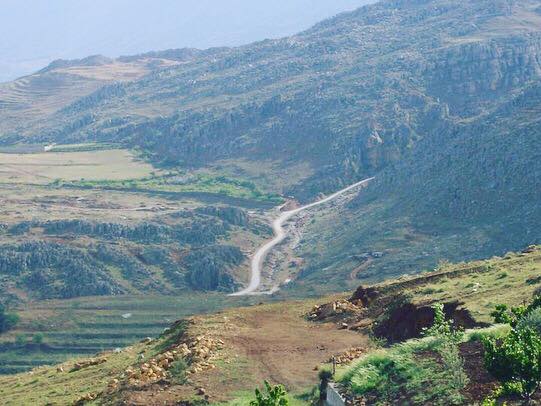In the opening scene of Ahmad Ghossein’s 2019 film “All this Victory” (Jidār a-Ṣawt), the protagonist’s wife comes across a makeshift school as she frantically tries to find her husband. He’s disappeared. She suspects he’s travelling south, to the heart of the battle with Israel. It’s July 2006, during the height of Hezbollah’s war with Israel. In the school, a clumsy magician performs tricks for an audience of displaced families, attempting to make a series of objects disappear: a Lebanese flag, a white dove and finally some technical equipment. But rather than disappear, the magician seems to draw attention to the objects, and to his own clumsiness.
The scene could be a comment on cinema in general. The process of making a film is a bit like performing a magic trick. The technical equipment and other production elements are supposed to disappear so that the narrative becomes visible. It’s a process that, like any magic trick, can be performed more or less clumsily. In the process, in spite of a director’s best attempts at control, the technical elements of the production can sometimes come to dominate the narrative.
"All this Victory” premiered at the Venice Film Festival in September 2019, winning a number of awards including, crucially perhaps, awards for technical achievements. But in Ghossein's hometown of Beirut, where the film has yet to be screened publicly, it has been met with controversy rather than adulation.

Rumours had long circulated in Beirut that scenes of a destroyed town in the film hadn’t been shot in South Lebanon, where most of the 2006 war and the bulk of filming took place, but in parts of Syria under Hezbollah occupation. Bidayyat, a non-profit based in Beirut that produces creative documentaries by young Syrian revolutionary filmmakers, published a series of articles asking provocative questions about the film: Was the permission granted to Ghossein to film in parts of Syria under Hezbollah control—an occupying force in Syria—actually an act of collaboration by the filmmaker? By portraying ruins in Syria in 2016 as destruction by Israel in 2006, was he endorsing Hezbollah’s propaganda narrative, which absurdly links its war to prop up the Assad regime with the struggle against Israel? And by using the destruction of towns forcibly emptied of their local populations in Syria as a film set, or “décor,” was Ghossein contributing to the erasure of the history of the Syrian revolution?
The articles were self-reflexive, pre-empting the argument that the film’s aesthetic value might be autonomous of the politics of its production, as well as the charge that they should wait to see the film before criticising it.
For critics of the film, the ethical issue at stake is the equivalent of, say, an Israeli filmmaker deciding to stage a film about the Holocaust in occupied South Lebanon.
No, the Bidayyat articles argued, it’s possible to criticise the way a film is produced without seeing it—in fact, it’s the reverse that doesn’t stand: it’s not possible to separate the film’s aesthetic merits, which might well be substantial, from the politics of its production. So, while Ghossein probably wanted the film’s production to fade into the background, the reverse happened. In Lebanon, the film’s narrative content largely disappeared from view while questions about the politics of production rose to the surface.
The scandal surrounding the film’s production concentrates on two brief scenes in the film, both showing a town laid to waste by war, which the main protagonist moves nervously through, both before and in the aftermath of Israeli occupation. They’re supposed to show South Lebanon, much of which was destroyed by Israel in July 2006, but which has since been rebuilt. A decade later, however, these scenes were shot in Zabadani, the first town liberated from the Assad regime by the Free Syrian Army during the Syrian revolution in 2012, which only fell back into regime hands in 2015 after a lengthy siege that killed many and culminated in the mass displacement of the local population by Hezbollah.
For critics of the film, the ethical issue at stake is the equivalent of, say, an Israeli filmmaker deciding to stage a film about the Holocaust in occupied South Lebanon.
Access barrier
The conditions under which images are produced and accessed has been a crucial issue since the beginning of the Syrian revolution in 2011. Since then, Syria has been largely inaccessible to foreign journalists. At first, foreign correspondents were refused entry by the Assad regime; and after the liberation of parts of the country from the Syrian regime, a series of high-profile killings, kidnappings and beheadings led to the broad consensus that rebel-held areas were too dangerous for journalists to access.

Since the beginning of the revolution, Syrian citizens have taken it upon themselves to “tell the world” what’s happening—at first filming grainy footage on cheap smartphones. They soon professionalised, buying better equipment and learning new skills, often becoming subcontracted as stringers (usually for exploitatively low pay) by international media organisations. In other words, the economy of image production has been marked by the politics of access in Syria since 2011.
The politics of access hasn’t spared documentary film production, either. To take another example, both of Feras Fayyad’s recent films, 2017’s “Last Men in Aleppo” (nominated for Best Documentary Feature at the Oscars in 2017) and 2019’s “The Cave” (which was subsequently nominated for an Oscar this year) effectively used the same mode of production as a satellite TV station. As both Aleppo and the Eastern Ghouta were under siege and aerial bombardment, they were dangerous to access (although many brave local journalists were still risking their lives in both areas at the time).* Fayyad, the director, remained across the border in Turkey, while local media offices were subcontracted to film the entirety of the two movies.
I’ve conducted interviews with some of those involved, who preferred not to be named. They described working on meagre pay, without insurance—despite the films’ large European production budgets. Some of the local filmmakers explained that they avoided making official or public complaints about their treatment, not wanting to detract from the revolutionary and humanitarian causes they hoped the films would promote. Even those who lost limbs, still uncompensated at the time I interviewed them, explained that despite their clear mistreatment, they “wanted the world to know” about the Syrian revolution, the reality of life under regime siege, and the ferocity of Russia’s aerial bombardments.** As media activists with years of experience, they were well aware of the indignity of causing a media scandal if word of their treatment were made public and they themselves became the story, rather than their political causes. In this case, the director’s magic trick seemed to work masterfully. The commitment of the young filmmakers (who’d been subcontracted to work on the film) to their political struggle for “freedom" and “dignity”, and their awareness of the snares involved in the logic of media scandal, made the reality of film production, always relegated to the background, disappear entirely.
The ethical questions that arise aren’t limited to issues of inaccessibility. Talal Derki’s “Of Fathers and Sons” (2018), which was also nominated for Best Documentary Feature at the Oscars, opens with an account of how the director gained access to a family of hardline Islamists in Idlib—supporters of Jabhat al-Nusra and ISIS. Derki describes in a voiceover how he told the family he was a war reporter with Islamist sympathies. This fabricated story is the ruse that lets the family’s guard down, granting Derki unfettered access to their domestic and intimate lives. The fathers and sons give candid and often skin-crawling accounts of their views of women’s education, suicide bombings, Westerners, infidels and other tropes associated with jihadism. They seem to condemn themselves and their own ideology with little prompting—at least from the perspective of a liberal Western viewer, which is also the public that Derki has clearly made the film for.
But there’s no context for these views. After the film’s release, local activists from Idlib complained bitterly on social media that the context of a struggle against both the Assad regime and Islamist groups had disappeared. The family that Derki films seem both traumatised and unhinged, especially after the father loses his leg by stepping on a landmine. They seemed ill-equipped to make an informed decision about granting Derki access and the sort of film he is making. One of the jihadist’s sons, a young boy under the age of ten during filming, complained that he and his late father had been misrepresented.
While watching the film, I felt like the sensational narrative and often spectacular images were disappearing entirely. What rose to the surface instead were the ethical decisions taken by the filmmaker during production: the politics of access.

All this access
In many ways the issues regarding the politics of access in these films by Derki and Fayyad are more obviously controversial than the two brief scenes in Ghossein’s film. There’s something far more direct about the exploitation of Syrians in the documentaries, not least because of their relationship to reality. And yet it was Ghossein’s fiction film that broke out into fully-fledged scandal on the pages of Biddayat.
As many of the Bidayyat articles discussed, and as I found out when I interviewed Ghossein, this had as much to do with the current political moment as Ghossein’s actions. Against a context of fraught and shifting relations between Lebanon and Syria, Hezbollah played a central role in repressing the Syrian revolution. The scandal also erupted a month before an uprising in Lebanon finally broke taboos that had largely forbade the public criticism of Hezbollah.
When I sat down with Ghossein to discuss the film and the controversy engulfing “All this Victory,” it was striking just how banal the process of gaining access to Hezbollah-occupied towns in Syria had been for a Lebanese filmmaker from the south. The majority of the film was shot in Ghossein’s ancestral village—Qantara, near Marjayoun—where Hezbollah dominates. He described how even shooting in his own home was a process that required applying for permission (idhin) from Hezbollah multiple times, sometimes for a single shot. At one stage, he told me, he decided to film a single shot of a car travelling up a winding road he could see from the kitchen window of his family home. Halfway through, he was stopped by a Hezbollah official and told that his permission didn’t extend to that particular valley. Once again, his production manager had to go through the process of applying for permission from Hezbollah, and only then could they go back to filming the scene.
According to Ghossein, although he stressed it was his own decision, it was the same production manager who first suggested filming the scenes of destruction inside Syria, knowing how relatively easy it would be to access. He naturally had contacts in Hezbollah, having worked on Lebanese and Syrian films and TV series (musalsalat) that had continued production throughout the Syrian revolution and war, navigating the border and the regime’s contracting and expanding control over territory. For these Syrian-Lebanese productions, and for production managers like the one working with Ghossein, it “didn’t make a difference whether he was working or filming in Lebanon or Syria.” Unlike the revolutionary productions discussed above, both involved exactly the same process for being granted access.
Hezbollah had made the gradual and well-trodden transition from liberators to perpetrators, relative victims to killers.
Since the process for gaining access to film from the authorities in South Lebanon and Syria were practically identical, for Ghossein it seemed to make continuing the production across the border less of a “decision.” But while the process for gaining access was identical, the politics of access in the two countries remained markedly different. The film brought into stark relief the radical transformation in perceptions of Hezbollah: from liberators of South Lebanon in 2000 following the first unilateral Israeli withdrawal from Arab territory occupied since 1982, to the authors of a self-proclaimed “divine” victory against Israeli invasion in 2006, to finally an occupying force waging a war abroad on behalf of foreign powers to put down a popular revolution. Hezbollah had made the gradual and well-trodden transition from liberators to perpetrators, relative victims to killers. The politics of access tapped into this shift: a narrative explicitly about the July 2006 war with Israel seemed to disappear, and in its place the film became a question of Hezbollah’s role in the brutal crushing of the Syrian revolution.
Ghossein is from a family of communists, and claims that he never considered Hezbollah to be liberators, that they hold hegemony over South Lebanon, and that he wanted to make the point that whether in Lebanon or Syria, these scenes of total destruction are what Hezbollah victories look like. The sarcasm of the title, "All this Victory," refers to the pyrrhic nature of those victories. The problem is, this point isn’t really apparent when viewing the film. And it also raises questions about why Ghossein chose such a radically different title for the film in Arabic—Jidār al-Ṣawt translates as “Wall of Sound” or “Sound Barrier,” and dodges entirely the sarcastic allusion to Hezbollah’s “divine victory.” (He claimed that a literal translation in Arabic “didn’t work." He also stressed that he clearly stated in the film’s credits that the two scenes in question were filmed in Zabadani.)
It’s true that Hezbollah fighters are hardly portrayed as heroes in the film: they’re invisible, always off screen. But neither are they portrayed as occupiers. If anything, the film itself reveals an ambiguous stance, which is no bad thing in itself, but it belies the criticism that Ghossein claimed to me to be making of Hezbollah’s role in crushing the Syrian revolution as a post-rationalisation. In fact, Hezbollah’s role in Syria seems if anything to be an afterthought, much like Ghossein’s own decision to film there. And once Ghossein had gone through the quite banal and frictionless process of being granted access to film in Zabadani, he could no longer conjure away the politics of Hezbollah’s role in crushing the Syrian revolution.
Ease and ethics
It seems to me that there’s an underlying issue at play across these films. Under new technological conditions, images are easier to produce in ever-greater quantities and speeds. New technologies also allow us to access images from across the world with increasing ease. Even if a filmmaker can’t travel across a border, images make their way cheaply and seemingly frictionlessly. But in turn, the ethical stakes related to the politics of access—whether on the scale of a satellite news channel, online media platform or for a filmmaker—are reconfigured.
Questions about the way images are produced are arising with increasing frequency and urgency, taking on a markedly ethical charge. There are two countervailing currents at play: the increasing ease of producing and accessing content brushes up against ever trickier questions about the ethics of production, circulation and access. It’s in the face of these global countervailing currents that Syrians have been at the forefront of responding to new ethical dilemmas. For example, the recent statement by over eighty Syrian filmmakers condemning filming in “destroyed and displaced Syrian towns and cities” as live crime scenes where war crimes and crimes against humanity were freshly committed; or the campaign by the anonymous film collective Abounaddara for a global “right to a dignified image” to be enshrined in international law. It’s noteworthy that as a global technological phenomenon, the ethical scope of these responses plays out in the realm of universal rights, especially in the case of Abounddara.
Filmmakers might wish to make what they consider the technicalities of production disappear—the magic of business as usual. But unless they think seriously about the way they’re producing their films and the politics of access, then the reverse can happen. As with so many of the dilemmas related to new media technologies—whether regulating images of violence, Russian disinformation campaigns, or re-purposing user-generated content as evidence of war crimes and human rights violations—Syrians have been at the vanguard of raising these issues, and proposing radical communal and global solutions.
The opinions expressed in this article are those of the author.
*Correction: An earlier version of this article previously stated that 'The Cave' was filmed in Douma, when it was in fact filmed in another area of the Eastern Ghouta.
**Note to readers: SyriaUntold received the following email correspondence from the Danish Documentary production company on March 11, 2020, which we felt important to share in the interests of transparency and to offer our readers a broader perspective on issues raised by this article regarding the film The Cave: 'The cinematographers [were] investing their time on a low salary until there was financing (this was agreed), and for that they got 50% of the rights to the revenues – which we later on negotiated back to Feras [Fayyad] and in return we paid them a higher salary. All parties [were] clear on this, there [are] no issues. Regarding insurances for the local team filming in Eastern Ghouta. We tried several insurance companies, but it was not possible to cover any Syrians with Syrians passports living in Syria. It was possible to make insurance for Feras [Fayyad] while working in Syria (because he had German Asylum and [an] address in Germany) – which we did. The Cinematographer who lost his leg, we compensated him with an artificial leg (25,000USD + 5 years guarantee) and paid all his medical treatment and physiotherapy with professionals. [He] was not shooting (working) the day the missile hit his house…[and] the location was not related to any shootings. We decided that we would pay and help him to recover. [He] is now in much better shape than when he first arrived Turkey in 2018. We invited and paid for all of the team coming to Los Angeles to take part [in] the Oscars, I believe they enjoyed the event and meeting everyone working on the film.'






